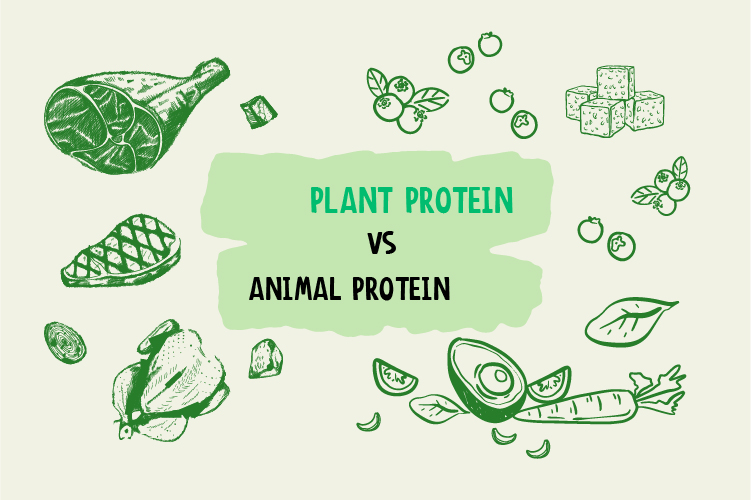
An often neglected but very important component of our diets has recently been brought back into the spotlight. Yes, we are talking about protein! From nutritionists, dietitians, health experts, your friends, family and even the Government of India, everyone has been highlighting the importance of consuming more protein.
So what exactly is protein and why is it being given so much importance?
What is protein?
Protein is one of the 5 essential food groups that are vital to maintain a balanced diet. The others being healthy fats, carbohydrates, fruits & veggies, and dairy.
This vital macronutrient is crucial to a number of health functions. It is present in every cell of the body and is a major component of skin, hair, bones, nails, muscles and organs. The body uses protein to make enzymes, which are needed for healthy digestion, blood clotting, muscle contraction, and energy production. Protein also strengthens the immune system, and aids in transporting nutrients to the cells. It supplies your body with energy while building and repairing tissue after injuries, workouts, surgery, and other forms of wear-and-tear.
What is protein made of?
Protein is made up of chained-together amino acids. Our bodies use 20 different amino acids to build protein. Out of these 20 amino acids, 11 are synthesized by our bodies whereas the remaining 9, called as the “essential amino acids” have to be derived from our diets.
Protein-containing food categories are classified as “complete” and “incomplete” based on the amino-acid profiles. Foods containing all the essential amino acids are called complete proteins and the ones who don’t are called incomplete proteins.
What are the common sources of protein?
Protein can be consumed from animals as well as plants. Some of the most common sources are lean meats, red meat, poultry, eggs, legumes, nuts, seeds, soy & soy products, grains like quinoa, vegetables, etc.
Animal protein, soy and quinoa are complete sources of protein as they contain all 9 essential amino acids whereas the majority of plant protein sources are incomplete. However, this does not imply that you cannot fulfil your daily recommended protein intake by consuming a plant-based diet.
Which is better: Animal protein or Plant protein?
There is an ongoing debate on which source of protein is better. On one hand, there is one school of thought which believes that only animal protein can help people meet their protein requirements. There is a contrary viewpoint which believes that a person can easily meet their protein requirement by combining a variety of plant proteins.
We will highlight the key differentiators between the two protein sources below:
Nutrient Profile
The macronutrient profiles of animal protein and plant protein are very different. While animal sources tend to be higher in protein content, they are also high in terms of saturated fat and cholesterol. Depending on the type of meat you consume, the levels of saturated fat and cholesterol will differ. Plant sources of protein tend to be higher in terms of carbohydrates and calories compared to animal sources of protein. They also are high in fiber whereas animal sources of protein contain little to no fiber.

Energy Density
Compared to animal protein, plant protein tends to be higher in terms of calories and carbohydrates except for soy. In simple terms, you would have to consume a larger quantity of plant sources of food in terms of calories and weight compared to animal sources to get the same amount of protein.
The table below from Optimising Nutrition shows a comparison of a range of different foods to ingest 100 grams of protein.

Bioavailability/absorption
The amount of a particular nutrient that can be digested and absorbed by our body is known as bioavailability. This is significantly important when it comes to protein.
The profile of amino acids present in animal protein are digested better compared to plant protein, thus offering higher bioavailability. Plant sources of protein have antinutrients that hamper the digestion of protein, vitamins and minerals. However, these antinutrients can be reduced or removed by preparing/cooking the plant sources of protein properly.
Associated Nutrients
The profile of associated nutrients differs significantly in animal protein and plant protein. Animal proteins contain a higher proportion of iron, vitamin D, vitamin B12, zinc and DHA. Plant protein, on the other hand, is a rich source of dietary fiber as well as micronutrients like potassium, calcium, folate, phosphorus, selenium, vitamin K, etc.
Which protein is better?
Both animal protein and plant protein have their pros and cons. Whilst animal protein has a higher protein content, better absorption, and contains essential nutrients, the high percentage of saturated fat and cholesterol can impact your health negatively. Also the impact of animal agriculture on the environment is a compelling reason to avoid consuming it.
Plant sources of protein can easily help you meet your daily recommended intake and achieve your health/fitness goals. The high dietary fiber content, absence of saturated fat and cholesterol, essential micronutrient profile of plant protein helps with improving heart health, weight management and reducing risk of lifestyle diseases. Whether you decide to go ahead with animal protein or plant protein, it is important that you consume the requisite amount of protein and other essential macronutrients in your daily diet.



